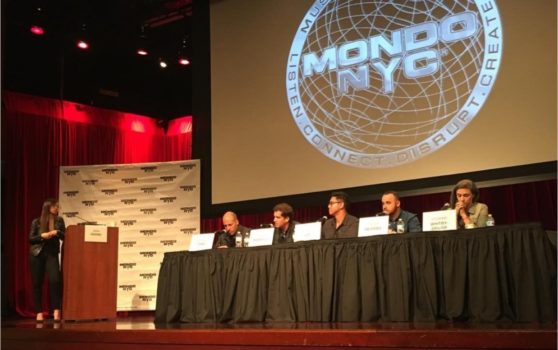
As anyone with an innovative idea has probably discovered, a great idea can only go so far without support, and when it comes to creating music content in the virtual reality space two key questions often arise: How to convince the music industry to support productions and how to keep fans coming back.
During a panel discussion called It’s Time To Pay Attention To VR at the Mondo.NYC music and tech conference and music festival at New York University’s Kimmel Center, six leading VR music content creators tackled these and other issues facing music VR content.

For one of the panelists, creative director Storme Whitby-Grubb, the answer lies in an approach she calls “thinking outside the headset†– finding ways to maximize the value of content that would appeal to budget-conscious record labels, artist managers and other key industry figures.
Whitby-Grubb, co-founder and creative director of the multiplatform studio Imagu, understands how to utilize both virtual and non-virtual content in creative ways in order to ensure that a label’s outlay has a good return on investment – and that fans will return for more experiences.
“If you have an artist that has a crazy dedicated fan base that will do anything for their artist, do the headset content,†she told me in an interview after the panel. “That’s great. But then lead that visual into something that could be offline, i.e., a ticketed event with, you know, a dome activation where people can go, because that’s real estate.â€
“That’s something a brand might want to get involved in, that’s something that could be ticketed, that could be sold,” she added. “That’s something that merchandise could be purchased.”
“You could bring a b-roll crew and shoot the event, so then you could social additional content. And then there’s a talking piece, and then there’s a press look.
“And that’s when I think things start to look a lot more attractive to a record company,†she said. “As opposed to, ‘We have to spend money on a piece of content and we have no idea how many people are going to watch it.’â€
Whitby-Grubb brings a music insider’s perspective to her work. The British-born creative director, who now calls Los Angeles home, spent 15 years as an artist manager and live tour producer until she quit managing two years ago and forged a new career on the creative side of the business.
She moved into music video production, and that led her to VR.
Initially, she said, she wasn’t familiar with VR at all, but contacts on the Los Angeles music scene came to her, asking her to concept projects for big-name artists.
“I was like, ‘VR? What? What? I don’t understand,’†she said. “That was about a year and a half ago, and, you know, the potential and the possibilities just really appealed to me because I have a very vivid imagination.â€
Whitby-Grubb may be in the VR world, but she’s not of it, and she said that her ability to communicate with labels, managers and artists on a peer basis is key to her success. She sees a disconnect in the way the tech and music communities relate to one another, and she feels her value lies in her ability to see the technology’s creative possibilities and to translate them in ways artists and labels can understand.
“I’ve had a very esteemed manager friend of mine say to me, ‘I’d never let a tech company loose in a room with one of my bands without me [meaning the manager] there,’“ she said. “Because that’s a business transaction.
“But when you come from, like, a video director world or, you know, the artist, the creative, the music industry world, it’s very different. They’re happy to leave people in a room together and just, like, blast out creative ideas.â€
As a child in England, Whitby-Grubb was a rabid music fan who frequented online chat rooms where she’d talk to people in America about music.
Like any music fan, she couldn’t wait to get the new releases from favorite artists. “When Radiohead would put a new single out, I would get the first train into central London and wait outside Virgin Megastore so I could buy CD1 and CD2 of “Paranoid Android,†she recalls. She’d chat with fellow music fans in line alongside her — a shared community based on mutual love for music.
She said she believes virtual and augmented reality offer the same kind of shared community experience, albeit in a higher-tech form.
“AR allows people to come – physically come together in a physical location but still be cool, still be tech, still be forward-thinking, still be exciting, still be new, still got that ownership for young people where, you know, the rest of us are like, ‘What?’†she said. “And that’s exciting.”
“So it’ll be interesting to see how that’s going to play out with consuming music, because I’m excited to see that space grow,” she said.
- How to get support for VR music content - October 12, 2017
